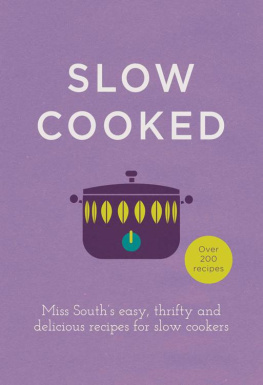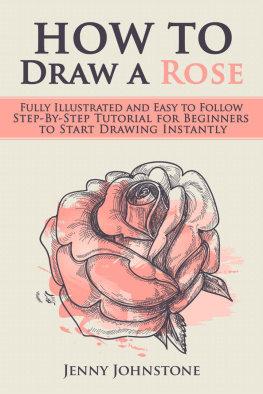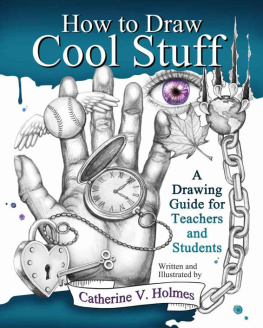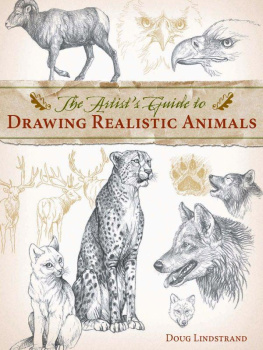Thank you to everyone who has contributed in any way to the creation of this book for your support, advice, and help. Many artists have generously shared their wisdom and expertise with me. A special thanks to my colleagues at About.com the forum members and those who have kindly contributed reference photographs.
Thanks also to my agent Barb Doyen, and my editor at Adams, Courtney Nolan.
I am indebted to all my past teachers for their commitment and inspiration, especially Sybil Small and Peter Jacobs, and to my students and art group members, from whom I learn as much as I teach. And of course, thank you to my parents Jim and Helen, and my sister Elaine, for their lifelong love and support.
1
Drawing Tools and Materials
An art store holds an abundance of creative goodies, selling everything from the finest artist's materials to the cheapest products available. This chapter will give you the information you need to make the wisest choices and the most economical purchases. Most of the materials you need to complete drawings in this book are relatively inexpensive. You can get started with whatever pencil and paper you have, though you will eventually want to get some artist's pencils, pen and ink, and charcoal, all of which are quite affordable. Most artists love experimenting, but start off with the basics and get to know them well before you start collecting a variety of products.
Paper
Most of the drawings in this book can be created on cheap office paper or sketch paper, but for permanent artworks, you will want a better quality paper. It might seem strange to spend good money on something as simple as paper; usually it seems plentiful and cheap. As the foundation upon which your artwork is created, the quality of paper can greatly influence the quality of your finished piece. You might also want to use a range of paper textures for different effects. A good-quality, acid-free paper will last well for many years, while most cheap papers become yellow and brittle after time.
Paper Pulps
Paper is made from a plant fiber called cellulose, with most paper such as newsprint, office paper, and books being made from wood pulp. Wood pulp paper contains the chemical lignin, which naturally occurs in the timber. Lignin causes the paper to darken upon exposure to air and sunlight and becomes acidic over time, weakening the paper. The acid in the pulp can be neutralized with calcium carbonate, (a process called buffering), but the effectiveness of this treatment diminishes as the paper ages.
Alpha cellulose papers are made from a very pure wood pulp and are considered stable. One hundred percent cotton paper is made from cotton linter, the short, leftover fibers from cotton ginning. The best paper is made from cotton rags. The fibers from textile manufacturers are long and strong; therefore, they yield a paper with superior strength and stability.
Paper is sized with gelatin or starch mixed into the pulp, which gives strength and helps protect the fibers from oxidization. Watercolor paper is also surface-sized, so that the paint tends to sit on the surface rather than sink into the paper.
There are advantages and disadvantages to every type of paper, and different media will have varying effects on different papers. Some expensive papers are designed for printmaking, so they are too soft and fibrous for drawing. Others, such as some heavily-sized watercolor papers, may have a slippery surface that seems to reject ink. The most effective way to learn about paper is through trial and error, by buying loose sheets of various types and experimenting with them. In this way, you will discover which paper suits your way of working.
Don't get hung up on finding the perfect paper or the right pencil. Great drawings can be produced with any old number 1 pencil and sketch paper. Good art materials offer consistent results, long-term preservation, and occasionally open up creative possibilities, but real drawing ability only comes from learning different techniques and practicing them.
Sketching Paper
Rough-sketching and line-drawing exercises can be done on any type of paper. Size A4 office paper is a perfect choice just be sure to choose a paper made from a renewable, local resource, not a tropical rainforest! Many of the drawings in this book, even the ink and wash, have been done on a good brand of photocopier paper. You will also want a larger-sized paper for big sketches, roughly A3 and A2 sizes. Choose any inexpensive, large sketch paper such as newsprint, MG litho, cartridge paper, or a large sketchpad. The purpose of this paper is for large, quick sketches, so you need to be able to use it without worrying about cost. While the lifespan of this paper can be limited, it will remain intact for many years, especially if stored away from sunlight. You can photograph or scan your work for a permanent record.
Drawing Paper
For detailed value drawings or anything that you will spend long periods of time working on, you will want to invest in a good-quality paper. For pencil drawing, you need paper with a bit of tooth enough to hold the particles of graphite from your pencil, but smooth enough to release them when erasing or blending. The surface must be tough enough that it won't disintegrate under repeated working. The best tooth is naturally provided by the fibers in the paper; it should feel faintly rough or velvety to the touch. Lightweight hot-pressed (smooth) watercolor paper is reasonably priced and suitable for pencil and ink work. Hot-pressed illustration board, or Bristol board, is popular with many artists and has a wear-and-tear surface, that tolerates erasing well and is available in varying weights. Its smooth surface is ideal for subtle pencil shading, especially in portraiture, where a flawless texture is important.
Pen-and-Ink Paper
Watercolor paper is available in hot-pressed (think ironed), which has a smooth surface; medium; and cold-pressed paper, which has a rough texture. I use a lightweight (185 gsm), smooth watercolor paper for pen and ink, and a medium-weight paper if I'm going to be adding a wash. When using washes, tiny puddles settle in the texture of the paper, so a smooth surface will give a smooth finish, while a rough surface can have a pleasing mottled effect, adding interest to simple sketches but not really suitable for detailed work.
Charcoal Drawing Paper
Charcoal can be used on regular sketch paper, though the surface tends to be resistant to erasing and blending, as the coarse, rough particles of charcoal catch on the large fibers. Surprisingly, the best paper is cheap, slightly shiny newsprint, with the short fibers of the wood pulp holding the particle well, but the smooth, rolled surface allowing for excellent blending and erasing. Regrettably, newsprint is highly acidic and deteriorates quickly, so it can't really be recommended for serious artworks.
Most pastel papers have a pronounced tooth, which is mechanically impressed on the paper; some have a meshlike pattern; others have a laid pattern, created by the vertical arrangement of wires in the paper mold. Velour papers are brushed to create a velvety texture, and some pastel papers have fibers added to the surface. Highly textured pastel papers are designed to take multiple layers of chalky pigment and are not really suitable for charcoal drawing, as it is difficult to manipulate the charcoal once it is applied.
Sketchbooks









